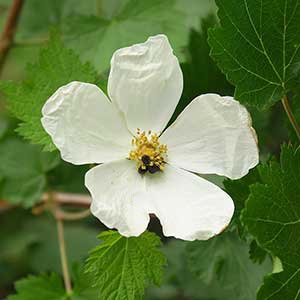Rubus bartonianus
Rubus nivalis
Barton's raspberry, bartonberry
dwarf snow bramble, snow bramble, snow dewberry, snow dwarf bramble, snow raspberry
erect, sparsely short-hairy, glabrescent, eglandular, not pruinose.
perennial, creeping, sparsely hairy, glabrescent, eglandular, not pruinose;
prickles sparse, strongly retrorse, stout, to 1 mm, broad-based.
deciduous, simple;
stipules lanceolate, 4–6 mm;
blade cordate to broadly ovate, (2–)2.5–4(–5) × (2.5–)3.5–4.5(–5.5) cm, base deeply cordate, 3–5-lobed, lobe apices acute to obtuse, margins coarsely doubly dentate, abaxial surfaces glabrous or sparsely hairy, eglandular or sparsely stipitate-glandular.
evergreen, simple or ternate;
stipules adnate to petioles, broadly elliptic to ovate, (6–)8–10 mm;
blade ovate to cordate, (2.5–)3–5(–8) cm, lobe or leaflet base cordate, shallowly 3-lobed, margins coarsely, singly or doubly dentate, apex acute to obtuse, abaxial surfaces with prickles along midveins, glabrous or sparsely hairy, eglandular, both surfaces lustrous fresh.
1-flowered.
1–2-flowered.
moderately hairy, eglandular or sparsely stipitate-glandular.
prickles scattered, retrorse, moderately to densely hairy, eglandular.
bisexual;
petals white, obovate, (15–)20–25 mm;
filaments filiform;
ovaries glabrous, styles clavate, villous.
bisexual;
petals magenta to pink, elliptic to oblanceolate or spatulate, (5–)8–10 mm;
filaments filiform;
ovaries moderately hairy, styles glabrous.
deep red, hemispheric, to 1 cm;
drupelets 10–30, coherent, separating from torus.
red, hemispheric, 0.4–1 cm;
drupelets 3–10, not coherent, separating from torus.
= 14.
Rubus bartonianus
Rubus nivalis
Of conservation concern.
Rubus bartonianus is distinguished from the other flowering raspberries within its geographic range by its erect, unarmed stems, relatively small, simple leaves with acute to obtuse lobes, deeply cordate bases, sparsely hairy or glabrous abaxial surfaces, relatively large flowers with white petals, and densely long-hairy, clavate styles. The leaves superficially resemble those of Acer glabrum or some species of Ribes.
Rubus bartonianus is most similar to R. neomexicanus but especially R. deliciosus. The species is known only from the Snake River Canyon of Idaho and Oregon.
(Discussion copyrighted by Flora of North America; reprinted with permission.)
Rubus nivalis is recognized by its creeping, prickly stems, simple to ternate, evergreen leaves, broadly elliptic to ovate stipules, two leaflets, relatively small flowers, and magenta to pink petals. Its closest relative is likely the Mexican R. pumilus Focke. Asian species previously classified in subg. Chamaebatus (Focke) Focke are hexaploid (M. M. Thompson 1997) and not phylogenetically close; R. nivalis appears to be sister to all blackberries of subg. Rubus (L. A. Alice and C. S. Campbell 1999; Alice et al. 2008).
The fruits of Rubus nivalis are eaten fresh, stewed, and canned by the Hoh and Quileute Indians (A. B. Reagan 1936).
The only known specimen of Rubus nivalis from California was collected in 1961 from Del Norte County at 1250 m near the Oregon border.
(Discussion copyrighted by Flora of North America; reprinted with permission.)
- Local floras:
BC,
CA,
OR,
WA
- Local Web sites:
CalFlora,
CalPhotos,
Flora NW,
PNW Herbaria
WildflowerSearch
iNaturalist (observations)
USDA Plants Database
- LBJ Wildflower Center
- SEINet
- Plants of the World Online
- Encyclopedia of Life
- Wikipedia
- Google Image Search


